OCZ Vertex 3 MAX IOPS & Patriot Wildfire SSDs Reviewed
by Anand Lal Shimpi on June 23, 2011 4:35 AM ESTAnandTech Storage Bench 2011
Last year we introduced our AnandTech Storage Bench, a suite of benchmarks that took traces of real OS/application usage and played them back in a repeatable manner. I assembled the traces myself out of frustration with the majority of what we have today in terms of SSD benchmarks.
Although the AnandTech Storage Bench tests did a good job of characterizing SSD performance, they weren't stressful enough. All of the tests performed less than 10GB of reads/writes and typically involved only 4GB of writes specifically. That's not even enough exceed the spare area on most SSDs. Most canned SSD benchmarks don't even come close to writing a single gigabyte of data, but that doesn't mean that simply writing 4GB is acceptable.
Originally I kept the benchmarks short enough that they wouldn't be a burden to run (~30 minutes) but long enough that they were representative of what a power user might do with their system.
Not too long ago I tweeted that I had created what I referred to as the Mother of All SSD Benchmarks (MOASB). Rather than only writing 4GB of data to the drive, this benchmark writes 106.32GB. It's the load you'd put on a drive after nearly two weeks of constant usage. And it takes a *long* time to run.
1) The MOASB, officially called AnandTech Storage Bench 2011 - Heavy Workload, mainly focuses on the times when your I/O activity is the highest. There is a lot of downloading and application installing that happens during the course of this test. My thinking was that it's during application installs, file copies, downloading and multitasking with all of this that you can really notice performance differences between drives.
2) I tried to cover as many bases as possible with the software I incorporated into this test. There's a lot of photo editing in Photoshop, HTML editing in Dreamweaver, web browsing, game playing/level loading (Starcraft II & WoW are both a part of the test) as well as general use stuff (application installing, virus scanning). I included a large amount of email downloading, document creation and editing as well. To top it all off I even use Visual Studio 2008 to build Chromium during the test.
The test has 2,168,893 read operations and 1,783,447 write operations. The IO breakdown is as follows:
| AnandTech Storage Bench 2011 - Heavy Workload IO Breakdown | ||||
| IO Size | % of Total | |||
| 4KB | 28% | |||
| 16KB | 10% | |||
| 32KB | 10% | |||
| 64KB | 4% | |||
Only 42% of all operations are sequential, the rest range from pseudo to fully random (with most falling in the pseudo-random category). Average queue depth is 4.625 IOs, with 59% of operations taking place in an IO queue of 1.
Many of you have asked for a better way to really characterize performance. Simply looking at IOPS doesn't really say much. As a result I'm going to be presenting Storage Bench 2011 data in a slightly different way. We'll have performance represented as Average MB/s, with higher numbers being better. At the same time I'll be reporting how long the SSD was busy while running this test. These disk busy graphs will show you exactly how much time was shaved off by using a faster drive vs. a slower one during the course of this test. Finally, I will also break out performance into reads, writes and combined. The reason I do this is to help balance out the fact that this test is unusually write intensive, which can often hide the benefits of a drive with good read performance.
There's also a new light workload for 2011. This is a far more reasonable, typical every day use case benchmark. Lots of web browsing, photo editing (but with a greater focus on photo consumption), video playback as well as some application installs and gaming. This test isn't nearly as write intensive as the MOASB but it's still multiple times more write intensive than what we were running last year.
As always I don't believe that these two benchmarks alone are enough to characterize the performance of a drive, but hopefully along with the rest of our tests they will help provide a better idea.
The testbed for Storage Bench 2011 has changed as well. We're now using a Sandy Bridge platform with full 6Gbps support for these tests. All of the older tests are still run on our X58 platform.
AnandTech Storage Bench 2011 - Heavy Workload
We'll start out by looking at average data rate throughout our new heavy workload test:
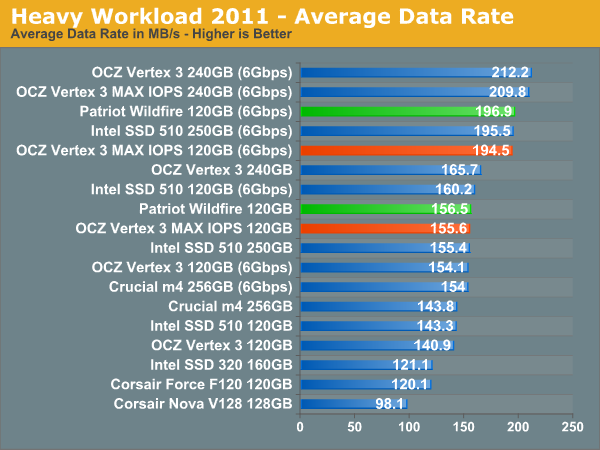
The breakdown of reads vs. writes tells us more of what's going on:
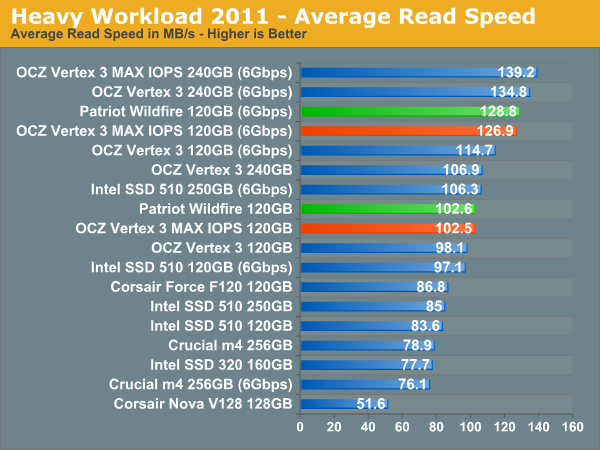
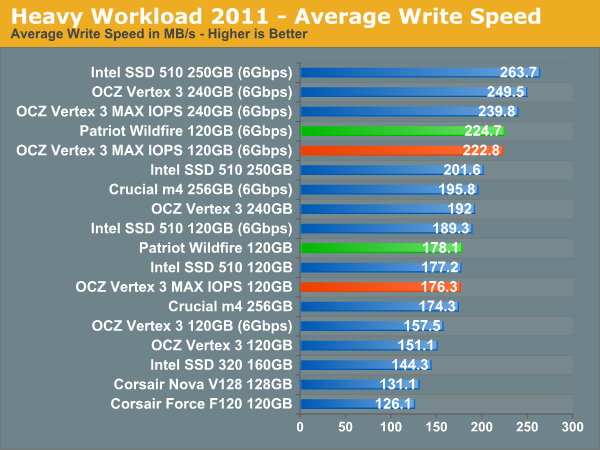
The next three charts just represent the same data, but in a different manner. Instead of looking at average data rate, we're looking at how long the disk was busy for during this entire test. Note that disk busy time excludes any and all idles, this is just how long the SSD was busy doing something:
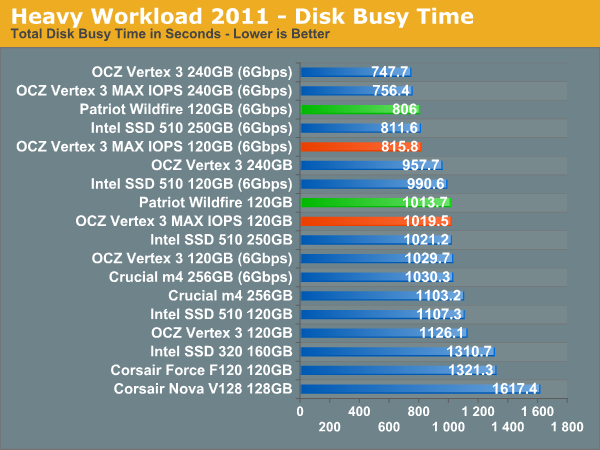
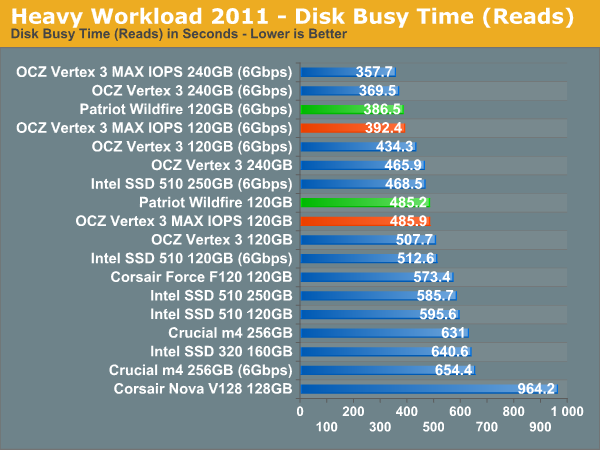
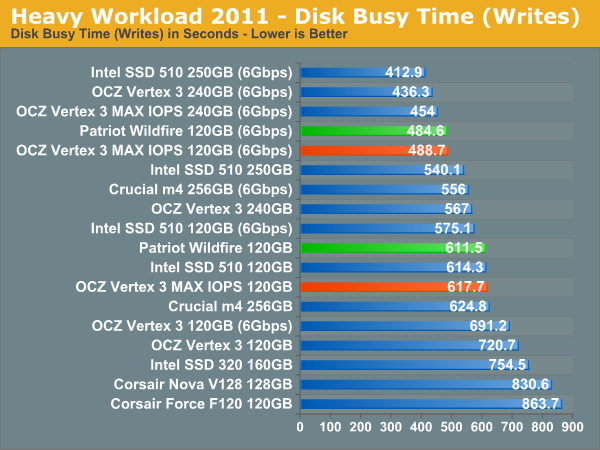










112 Comments
View All Comments
poohbear - Thursday, June 23, 2011 - link
Thank you for being upfront at the very beginning about "the elephant in the room"! some sites were blamed for ignoring the issue, but u guys were spot on about it and to be honest its one of the main reason i've been steering clear of any Sandforce 2000 based SSDs. two thirds of a percent? why give it in such a complicated way???? two thirds of a percent is .6% of all drives? why not just say 1% of all drives, but yea i understand disgruntled consumers are often the most vocal about a problem.Nice review though, might look into this when they have some new and more mature firmwares. Right now im fine with my Crucial C300 64gb.^^
bivoy - Thursday, June 23, 2011 - link
strange, my A DATA SSD 599 (sandforce 1XXX based) has died two weeks ago when I left notebook in sleep mode overnight .......iron11 - Thursday, June 23, 2011 - link
After reading many reviews of OCZ, I went ahead and bought 2 of them. Let me tell you.. 2 months of owning these SSD's... BSOD's over and over and over and over again. Look at OCZ forums and tell me that its a 1% failure rate. I really hope anyone who's thinking of buying these SSD's look into Intel 510/320's. They're reliability/speed is there. I will never buy OCZ again.. i'll pay the extra surcharge fee Intel charges. I'll pay it not for the name.. but the track record behind Intel's SSD.OCZ = Bad
seapeople - Thursday, June 23, 2011 - link
As explained in this article, the OCZ BSOD issue is not a reliability issue whereby drives degrade in quality and "break", but rather a compatibility issue with certain system configurations. If your system is incompatible with the Sandforce-based drive for an as-yet undetermined reason, then EVERY similar Sandforce-based drive will give you BSOD's. This explains why there are such conflicting reviews of these drives: reviewers like Anand can put dozens of these drives into a few different systems, and because none of these systems have a compatibility issue the drives work perfectly. Meanwhile the people who do have a system-compatibility issue can RMA a dozen of these drives and every single one of them will fail.It sounds like if you take on of these BSOD drives out of a user's system and put it in a different system it will work perfectly, which is part of why OCZ is having such trouble diagnosing the issue.
All that said, I'm glad I bought an Intel.
spidey81 - Thursday, June 23, 2011 - link
I was curious to see current pricing and availability after reading this article and found a little surprise. When Anand spoke about the price premium not being worth the jump up to the MAX IOPS from the base V3 I wanted to look myself and see what they were going for or if there were any deals. What I came across was a Corsair Force 3 for $180 after rebate ( $210 without ). This is the drive mentioned in the first page of that article that Corsair recently recalled. But the problem has been addressed and this seems like a hell of a deal!Beenthere - Thursday, June 23, 2011 - link
As we see with many PC products these days, many are shipped well before they are ready for primetime. Sure those who only use their PC for games might be willing to buy unreliable, half-baked products but no one with a clue would touch these unreliable products. As long as the sheep line up to pay a premium for the half-baked product of the week, manufacturers will continue to ship half-baked crap and there are numerous popular brands who routinely do this as noted by the product defect reports.Axonn - Thursday, June 23, 2011 - link
I think Anand forgot to mention another reason why the V3 MI is worth it: 32nm NAND means it has more life cycles in it.Impulses - Thursday, June 23, 2011 - link
Honestly, how many times have we as enthusiasts encountered a particular motherboard (even on a business class laptop) that didn't play will with a certain brand of RAM or vice versa, or a GPU that was unstable on certain platforms, etc etc. When you're a DIY enthusiast this comes with the territory... There's always gonna be some products/brands that are more reliable, if you value your time a lot then opt for those.I don't see anything wrong with AT's coverage as is, he has ALWAYS mentioned that Sandforce drives pose a reliability risk (vs Intel) in the same breath that he talks about their performance... If you visit message boards this has always been quite obvious. If anything I'd just hope for a quicker mention of some of the emerging issues.
I understand Anand can't document something he hasn't experienced and I imagine getting info from OCZ is hard when they haven't been able to pin down the problem, but still, an earlier warning that there might be a very real issue would be good (regardless of how uncommon).
npp - Thursday, June 23, 2011 - link
The current prices of the third generation Vertex drives here in Germany:OCZ Vertex 3 240GB: 198,51€ (MAXIOPS Version: 247,50€)
OCZ Vertex 3 240GB: 422,68€ (MAXIOPS Version: 485,98€)
If you want the prices in USD, do the math for yourself, but one thing is clear, those don't come cheap.
Personally, I wouldn't bother spending so much money on a drive with *known* issues. It's plain unreasonable. A 300GB Intel 320 drive costs 429€ around here, so you get the point. Sure, it's a "last gen" drive and slower on paper per se, but I'm sure even Anand will be hard pressed to tell the difference from a Vertex 3 in real life.
OCZ played it really when with the second-gen Vertex, but I think they got a bit of an overshoot this time. Given how fast SSD are to begin with, I would be perfectly fine with more incremental changes between generations, if that means better reliability. Going for the big figures and then getting BSODs isn't the right way to do things, I think. Issues such as those still hold me back from getting a SSD in my notebook. I typically use a system for about 3 years before upgrading, and I want a drive that will cut it through all that time without a glitch. Given that even Intel messes things up occasionally, I wonder when such a drive will make it to market.
Makaveli - Thursday, June 23, 2011 - link
"There's a percentage of OCZ Vertex 3/Agility 3 customers that have a recurring stuttering/instability issue."This is unacceptable on a storage device that will host an operating system, I don't care if this thing pushes 1 million ops and takes out the garbage.
And still the reason I only look at intel drives for ssd.
Stability > speed when it comes to storage devices.